October and November mark the Himalaya’s short clean transition between monsoon and winter, i.e. the autumn. During this six or, if fortunate, up to eight weeks window, three things align in favour of your trekking tour in the Himalayas.
- Dry air you can trust – the rains have spent themselves, leaving firm tracks and sun-dried canvas before nightfall.
- Clear-sky mornings – dawn light carves distant ridges in sharp relief, giving a generous hour of gold for the camera and the memory
- Forgiving snowlines – fresh powder stays well above the 4 000-metre belt, so you travel light while still tasting real altitude.
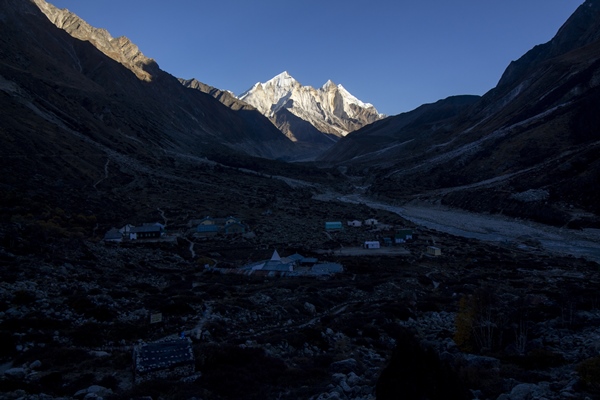
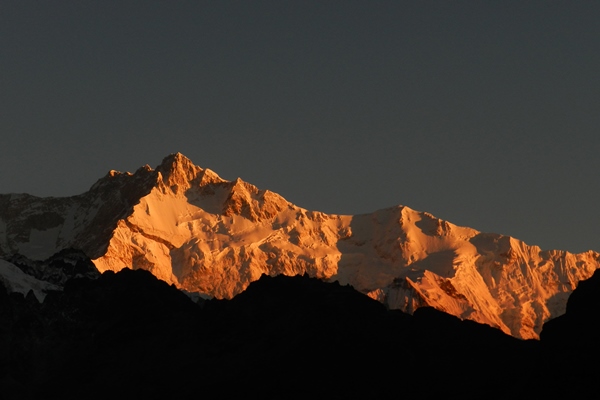
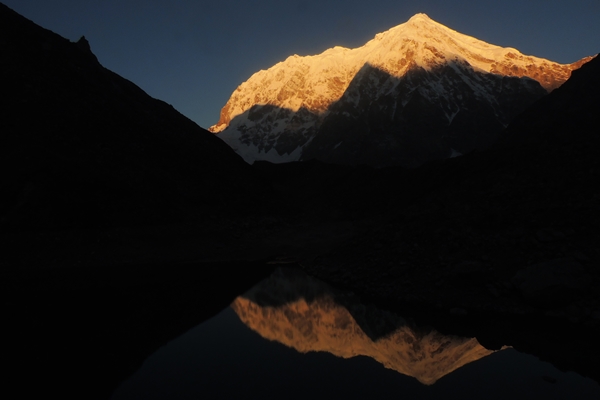
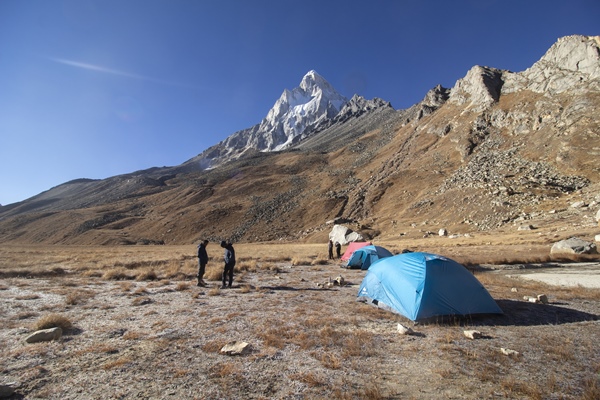
Put practically, autumn lets you climb high with light gear, wake to sketch-book horizons, and still sleep inside a three-season sleeping bag. It is also a near-perfect time for photographic enthusiasts who want a clear weather guarantee yet do not want to miss out on colours.
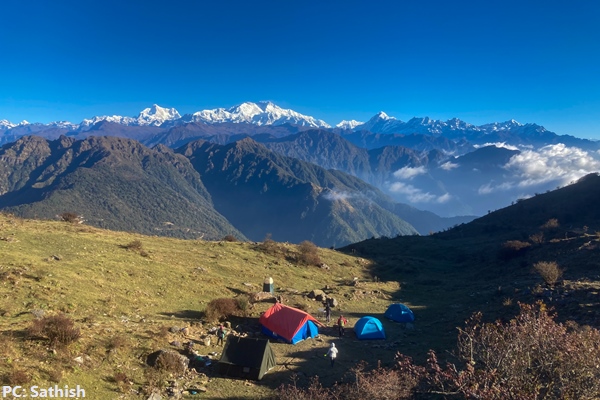
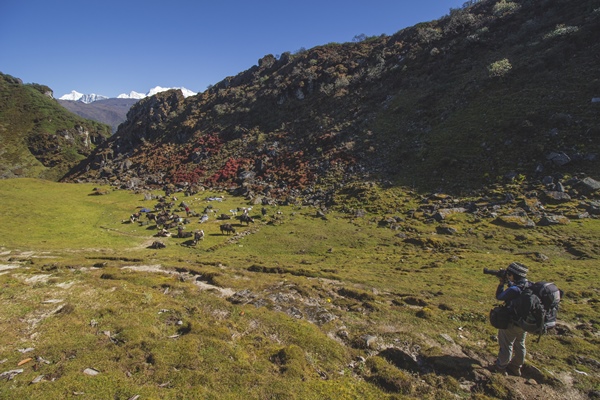
But only if you match the route to the right region and height
That mix is why our “best of” list leans entirely on Sikkim–Darjeeling and Uttarakhand: they deliver long ridge views, steady temperatures around 12 °C to 18 °C at 2 000 m, and just enough chill at night to keep leeches and midges away—while Himachal, Kashmir and Ladakh have already traded monsoon mist for early snow and hard ice. Pack a spare weather day and a –5 °C bag for anything above 4 000 m, and you’ll meet the mountains at their most welcoming.
So spend some time reading this article that will give you not only the best treks to go for in autumn but also the right reasons for doing so.
Understanding the weather & climate for autumn
No wonder that a 2500 km wide mountain range with considerable latitude variation from north to south will show different weather and climate at a given time. As a matter of fact, as stretching from east to west, the Himalayan range also gets its latitude gain, i.e., westerly is more northerly (i.e., in turn, more cold and early snow, lower snowline and treeline).
Weather and data disclaimer: These figures blend India Meteorological Department normals, trusted third-party datasets, and our own on-trail logs from the last decade (2014 – 2023). Even so, Himalayan weather can swing outside any average—Bay-of-Bengal low-pressure systems, western disturbances, or localised cloudbursts may alter conditions with little warning. Treat the numbers as a planning guide, not a guarantee, and always check live forecasts, carry a spare weather day, and pack for a wider temperature and rainfall range than the tables suggest.
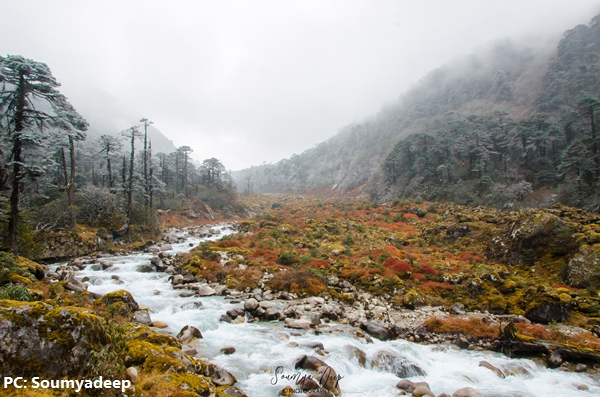
Clear-sky dividend
By the last week of September, the monsoon is usually ready to leave, even in the wettest areas, such as the Eastern Himalayas that includes Sikkim and Darjeeling region.
Various satellite data reveal that cloud cover in Sikkim and Darjeeling declines by over 45% between September and October, resulting in an average of 17–18 clear days per month by the time Diwali lamps are lit. In November, visibility can reach 150 km (yes, the Kanchenjunga massif, even from Siliguri), which is enough to frame four 8000-metre peaks in a single ridge-top panorama or the close-up amphitheatrical views.
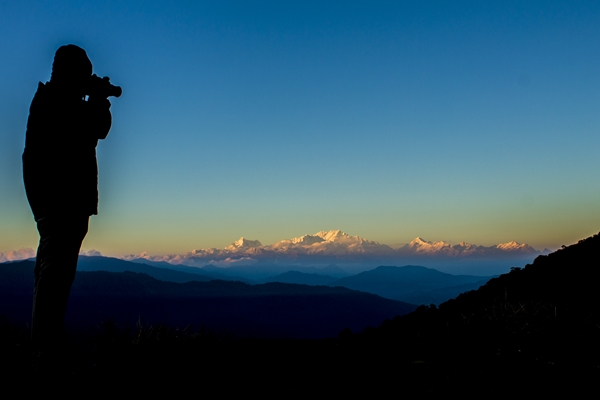
Clear skies are also prevalent throughout the rest of Uttarakhand and further west, up to Himachal Pradesh and Kashmir, making them potential trekking or holiday destinations.
Rainfall finally sits down
Post-monsoon rainfall collapses to < 140 mm in October and < 50 mm in November around Sikkim–Darjeeling, compared with 600 mm+ peaks in July–August. Garhwal and Kumaon and so as the Himachal see similar drops—yet western flanks cool faster, edging towards freezing nights by early-November.
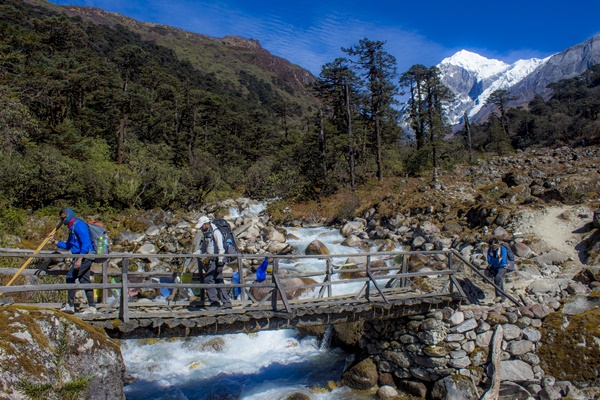
| Destination (ref. town) |
Oct rain (mm) |
Nov rain (mm) |
Rainy days (Oct) |
Rainy days (Nov) |
On-trail weather take-away |
|---|---|---|---|---|---|
| Sikkim–Darjeeling (Pelling / Darjeeling) |
≈ 125 | ≈ 30 | 4 – 10 | <1 – 4 | Monsoon gone by early Oct; odd Bay-of-Bengal shower first week. Nov almost bone-dry with crystal mornings. |
| Uttarakhand (Mussoorie / Uttarkashi) |
≈ 45 | ≈ 10 | ~3 – 5 | 0 – 2 | Dry, stable right to ~20 Nov; first western-disturbance snow on high ridges late Nov. |
| Himachal (Manali) |
≈ 25 | ≈ 30 | ~2 | ~2 | Driest stretch of year; brown slopes, crisp air. Light peak snow possible after mid-Nov. |
| Kashmir Valley (Srinagar) |
≈ 22 | ≈ 28 | 4 – 5 | 5 – 6 | Pleasant sweater weather early Oct; high-route season ends early-Oct as frost & first snows arrive. |
Gentle days, cool nights
From the below chart we can observe that the mid hill altitude bands around 2000 m remains farily conducive to begin your holidays and acllimatisation. It is also to note that, as we move from east to west, things not only get colder but harsh and arid.
| Reference town (altitude in m), Region | Oct avg max / min (°C) |
Nov avg max / min (°C) |
What the numbers mean on trail |
|---|---|---|---|
| Darjeeling (2040) | 20 / 13 | 17 / 10 | Spring-like days; frost rare till Dec — ideal for Sandakphu–Phalut ridge walks. |
| Pelling (2150), West Sikkim | 17 / 9 | 14 / 6 | Light to moderate fleece nights; snowline > 4 200 m — perfect for Dzongri warm-ups or Bajre Dara camps or an epic journey to Goechala till the end of Nov. |
| Lachung / Lachen (≈2750 ), North Sikkim | 8 / 0 | 2 / –6 | Cold already; carry –5 °C bag. Late-Oct snow flurries common — high North-Sikkim routes turn wintry fast. |
| Mussoorie (2005), lower hills, Uttarakhand | 22 / 12 | 19 / 9 | Clear, mild; 0 °C bag enough for Dayara, Kuari & other ≤ 4 500 m treks through Nov. |
| Joshimath (1875), Garhwal | 12 / 2 | 8 / –2 | Brisk afternoons, freezing nights; Tapovan, Pangarchulla & similar ≤ 4 500 m routes stay feasible till Oct end. |
| Munsiyari (2200), Kumaon | 17 / 6 | 14 / 3 | Cool but dry; Ali–Bedni & Khaliya ridge walks remain snow-free until early Dec. |
| Manali (2050), Kully valley | 21 / 10 | 15 / 5 | Comfortably cool early Oct; Hampta & Bhrigu close soon after mid-Oct as frost spreads. |
| Kaza (3800), Spiti | 1 / –10 | –4 / –16 | Winter-like; water freezes all day by Nov — trekking largely ends when nights dip below –15 °C. |
| Srinagar (1585), Kashmir | 20 / 7 | 14 / 2 | Pleasant sweater weather in Oct; late Nov dawns often frost-tipped — long routes wrap up. |
| Sonamarg (2800), Kashmir valley | 14 / 4 | 5 / –3 | Fast cooldown; autumn treks wind down by mid-Oct as first snow blocks passes. |
| Leh (3500) | 10 / –7 | 5 / –10 | Cold start, freezing finish; most trails close by early-Oct — only day walks remain viable. |
| Padum (3660), Zanskar | 10 / –7 | –6 / –18 | Short autumn; late-Oct already sub-zero all day — Zanskar treks exit as Oct begins. |
Why Ladakh, Kashmir and even most of the Himachal Pradesh step aside in autumn?
Higher latitude and a continental interior spell brings earlier winter. Western disturbances can cause snowfall at 3000 m or above as early as during October in Kashmir. For the Leh-Ladakh, along with Zanskar and the surrounding areas of Himachal that includes Lahaul Spiti and Chamba region also are prone to earlier snowfall and anothing around 4000 m or above car be farily challenging and risky to venture in autumn.
E.g., in Srinagar—a relatively low 1 600 m—average highs fall to 14 °C in October and 8 °C in November, with lows flirting with 3 °C. Above 3 000 m, frost firms waterlines and shepherd trails, so multi-day treks wrap-up by early-October.
Destination-wise, practically the areas of the far western and northern Himalayas, including Himachal Pradesh, Leh Ladakh and Kashmir Valley, become not only unfavourable; at the same time, they lose the very beauty and charm of the trails which they are widely recommended for.
October–November is the sweet spot for Himalayan trekking—clear, cool, and dry from Sikkim-Darjeeling in the east through Nepal’s spine to the trails of Uttarakhand in the west.
So now that we know our destinations and regions to look for, its good time to take a look at the below treks which we highly recommend during autum.
15 best treks in autumn that you will love:
In typical fashion, our list includes treks from different states and regions, ranging in length from shorter to longer. While some of the treks on our list are for newcomers, there are also plenty of options for more seasoned hikers. Below you’ll find our favourite October–November routes, grouped by region.
1. Sikkim and Darjeeling treks:
Notes and pro tips: All treks going up to 4500 m or around and camping at 4000 m+ are possible throughout Oct and Nov. Forests remain modestly green, even during November with some foliage and amber. If rain is a no-no to you, plan after the middle of Oct. By middle of Nov high camps become cold, droping as low as -15°C
Goechala or shorter Dzongri trek
Key facts and figures: Moderate to strenuous grade, 5 to 8 trekking days; 5o to 80 km, up to 4600 m/15100 ft.
Attractions, why now: The most iconic and popular trail in Sikkim, outsdtanding peak views from Dzongri and Goechala View Point 1, dense forest inside the Kanchendzongha National park – a UNESCO heritage site, Yuksom – the first capital of Sikkim, Tsokha and Dubdi monastery.
Sandakphu Phalut or shorter Sandakphu trek on Singalila Ridge
Key facts and figures: Moderate or Easy (shorter one) grade, 3 to 5 trekking days, 45 to 70 km, to to 3636 m/11800 ft.
Attractions, why now: Four 8 000 m peaks——visible along the Singalila crest with Sleeping Buddha formation of Kanchenjunga and surrounding peaks, Tea-house bed comfort; bamboo and barberry turn red along the path inside Singalia Niational Park, crystal views set in by mid-Oct and hold through entire November.
Bajre Dara trek
Key facts and figures: Easy to Moderate grade, 3 trekking days, 30 km, up to 3350 m/11000 ft
Attaractions, why now: Short campnig trek with fairly close views of Kanchenjunga and other peaks in Sikkim, bamboo and Rhododendron forested trail becomes dry and firm, boot shaped Khecheopalri lake and monastery to end with.
Dafeybhir – Sikkim Alpine lakes trek or longer Round Singalila Dzongri trek
Key facts and figures:
Attaractions, why now: String of high altitude lakes on a train developed by Tenzing Norgay; crowd free uninterrupted ridge walking on the Nepal–Sikkim border while peaks getting closer, Yak herders descend for winter, trail can be connected to Dzongri via HMI basecamp route for a complete circuit, route is inside Kanchendzongha National Park.
Phoktey Dara trek
Key facts and figures: Easy grade, 5 trekking days, 50 km, up to 3700 m/12150 ft.
Attractions, why now: Pristine forests inside Barsey Rhododendron sanctuary, reverred Sleeping Buddha formation centering Kanchenjunga, exquisite panoramic views during sunrise and sunset, charming campsites, picture postcard views in late Oct and Nov.
2. Uttarakhand treks (Garhwal & Kumaon)
Note: Treks going to 4500 m or a bit higher and that requires camping at 4000 m or above are to be completed by Oct. Nov becomes tricky for these treks due to errant snowfall chances and scarcity of water enroute.
If you are particularly looking for those treks going really high and often around 5000 m or above, then we suggest checking our guide for the best trekking options in September, the time traditionally considered the best window for these kinds of treks.
Gaumukh – Tapovan trek (finish by Oct)
Key facts and figures: Moderate grade, 5 trekking days, 50 km, up to 4350 m/14270 ft
Attractions, why now: Iconic Shivling and Bhagirathi tower directly above the glacier’s grassy bench, crisp, low-moisture air gives unobstructed peak views; glacier remains firm with minimal chance of October snowfall.
Deoriatal Tunganath Chandrashila trek
Key facts and figures: Easy to Moderate grade, 3 days walking, 20-30 km, up to 3800 m/12500 ft.
Attractions, why now: Lake reflecting the four-spired Chaukhamba massif. A short pre-dawn stroll puts the first sunburst exactly on the summit ridge, Post-monsoon dust has washed out; October skies deliver the sharpest reflections of the year, 200° skyline from Chandrashila taking in Nanda Devi, Trishul, Kedarnath Dome, Gangotri group and the full Chaukhamba wall, Tunganath is highest Shiva shrine on earth, built in local stone, can be done in Tea-house infrastructure in a light mode without camping.
Har Ki Dun plus Ruinsara Tal – Bali Pass trek (finish by Oct)
Key facts and figures: Easy to Moderate, Bali Pass is high and tricky, 35 to 70 km, 4 to 8 days of walking when combined, up to 4880 m/16005 ft at Bali Pass.
Attractions, why now: First snow seldom before late Nov at Har Ki Dun; valley temps 8-10 °C day, 0 → –5 °C night—river fords clear and turquoise,Village fields in full amaranth (chaulai/ramdana) harvest, towering views of Swargarohini from Bali Pass (cross by mid to late Oct).
Ali Bedni Bugyal trek
Key facts and figures: Easy to Moderate, 4 trekking days, 35 km, up to 3800 m/12500 ft
Attractions, why now: Twin meadows with direct Trishul & Nanda Ghunti frontage; a panoramic sunset line with many other peaks in Kumaon and Garhwal; grasslands flush with golden; and post-monsoon clarity deliver never-ending ridgelines on lower slopes.
Pindari Glacier trek
Key facts and figures: Moderate, 6 trekking days, 70 km, up to 3750 m/12300 ft
Attractions, why now: 20 odd peak of Kumaon from Dhakuri on the head of Pindar and Sunderdhunga valleys, after monnsoon haze goes away from the valley, some foliage, glacier and icefall remains clearly visible.
Saptakund trek
Key facts and figures: Moderate grade, 6 trekking days, 60 km, up to 4450 m/14600 ft.
Attractions, why now: New and fairly high route that can be attempted till mid of Nov, small alpine lakes at the base of Nanda Ghunti massif, pristine meadows turn golden, fresh views of the high Garhwal peaks, trail inside oak and rhododendron forest, intrior villages to start and end the trek.
Kuari Pass trek with Pangarchulla peak
Key facts and figures: Easy to Difficult (Pangarchulla summit) up to 4550 m/14925 ft
Attractions, why now: Panorama rich pass, north slope has all the mountain views, Pangarchulla summit sees 20-plus peaks: Nanda Devi, Kamet, Chaukhamba to Kedarnath Dome. October offers clear scree and no/minimal ice; success rate drops once pre-winter snow starts in November.
Satopanth Tal trek (finish by Oct)
Key facts and figures: Moderate grade, 4 to 5 trekking days, 50 km, up to 4400 m/14430 ft.
Attractions, why now: Alpine lake with massive reflection of Chaukhamba at the heartland of Garhwal, series of Peaks towering above or around the value, some early autumn foliage, moraine an debris remain stable after post monsoon, pristine without any Pilgrims, cold nights inside the valley.
Dayara Bugyal trek (can be combined with Dodital)
Key facts and figures: Easy grade, 3 trekking days, 20 km, up to 3660 m/12005 ft. 6 trekking days with Dodital – Darwa Top combo.
Attractions, why now: Rolling high-pasture opens full Gangotri range: Bandarpoonch, Draupadi ka Danda, Srikanth. Meadows turn honey-gold; October day 10-15 °C, nights 0-5 °C—perfect camping without snow risk. Dodital add a lake that has legend as birthplace of Ganesha, fantastic peak views from Darwa top.
So now that you have a firm idea about the best treks in autumn, which one will you choose? Or rather, which area do you prefer to visit? Feel free to get in touch with us so that we can help you with shortlisting the ones that fit you better.



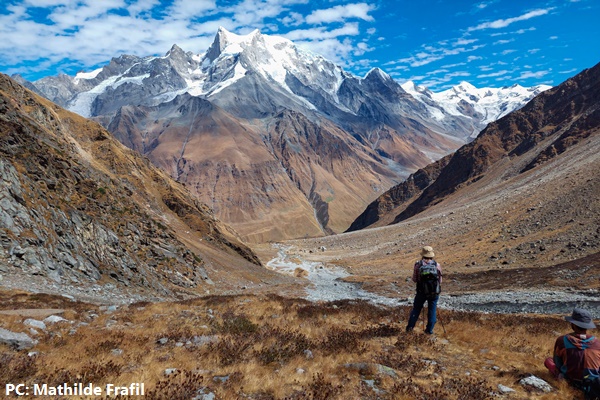





Comments